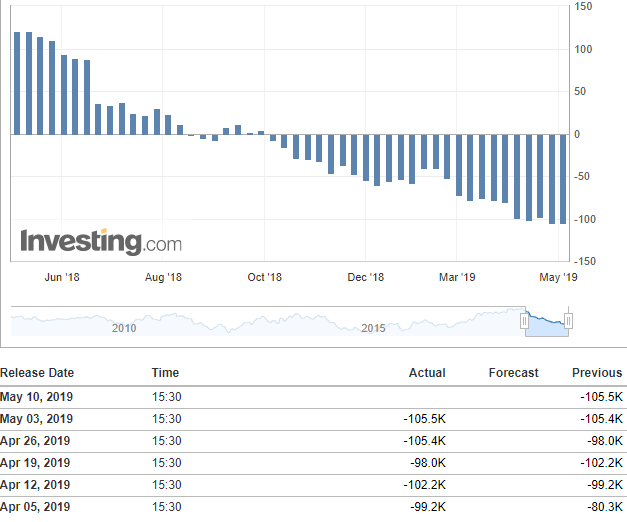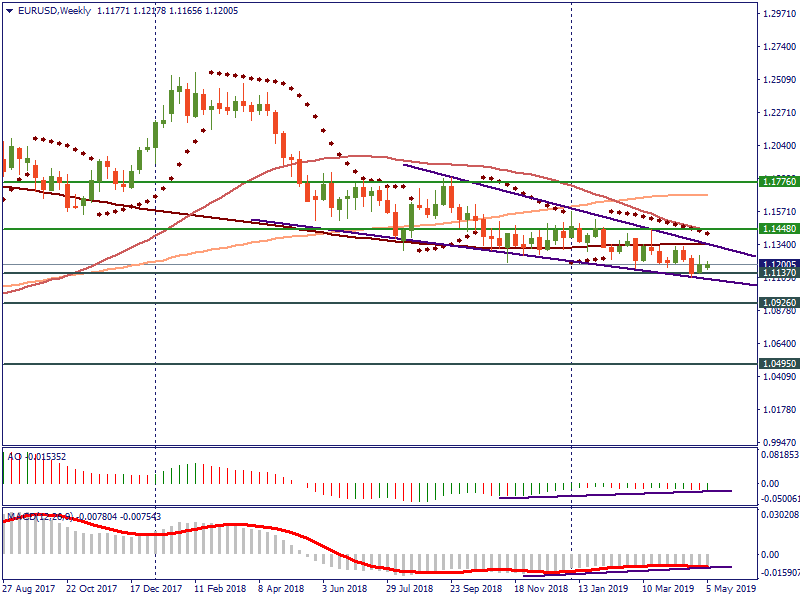
O cumprimento dos cortes de produção da OPEP+ aumentou, com as exportações a caírem cerca de 900.000 barris em fevereiro, o nível mais baixo desde agosto/23
2019-11-11 • Atualizado
Recent European economic data seemed to bring optimism to the euro area. European prelim flash GDP growth for the first quarter of 2019 surprised investors with an upbeat. The actual release outperformed the forecast by 0.1%. Spanish flash GDP figure exceeded estimates too. Even Italian data was quite promising - prelim GDP level was placed at 0.2% against -0.1% forecast. German prelim CPI level beat the forecast by 0.5%. Sound good but the long-term picture may be not that shiny.
On May 7, the European Commission published its economic forecasts*. According to them, the European economy will keep suffering during 2019 with a rebound in 2020 only. The GDP growth is anticipated to be at 1.2% comparing to 1.9% in 2018. The unemployment rate should stay at 7.7%. This figure is better than previous ones but not the best. The summary budget deficit in the eurozone is expected to rise to 0.9% of GDP. Although debt of the eurozone will likely decrease, it’s not enough to boost the euro.
In April, eurozone economic sentiment fell to its lowest level in more than two years. What more negative for the European currency is a prediction of low inflation levels both in 2019 and 2020 that is below the ECB’s targets.
Moreover, we should remember about the external factors that will be adding pressure during the year. Trade wars leading to the weakness in emerging markets, especially in China. The Brexit deal that is constantly prolonged may end with a no-deal at all.
All factors mentioned above are signs of the weak EUR.
CFTC EUR speculative net positions keep moving down from week to week signaling weakness of the euro. What is next?

What levels to expect for the euro.
Last time, the EUR/USD pair was at current lows in May-June 2017. The pair keeps trading in the downtrend and although some analysts were sure that accommodative monetary policy of the ECB and external threatens are already priced in, the European currency can’t recover. On the weekly chart, awesome oscillator and MACD formed a bullish divergence with the price chart that was reflected on the chart with a rebound of the pair. The rebound from 1.1137 is positive for the currency but the downward pressure will likely continue. During the upcoming months, we can anticipate a further decline. A breakthrough below 1.1137 will provoke a further decline towards 1.0926 – the bottom line of the previous consolidation. If EUR/USD plunges below 1.0926, the next support will lie at 1.0495. The level is far but additional pressure may lead the pair to it. Recovery of the EUR/USD may happen if only there is a progress in external threats that will cause an improvement in the European economy. Bulls need to push the pair above 1.1448. Only after the pair is above this level, we can hope for the recovery of the European currency.

To conclude, the euro is anticipated to suffer during the year. Negative economic forecasts, easing monetary policy of the ECB and external factors don’t give the currency a chance to recover. If only the situation improves, the EUR will get an opportunity to recover.
* EU Economic Forecasts is the report that includes economic forecasts for EU member states over the next 2 years.

O cumprimento dos cortes de produção da OPEP+ aumentou, com as exportações a caírem cerca de 900.000 barris em fevereiro, o nível mais baixo desde agosto/23

Na ocasião, os mercados estarão analisando esses dados (principalmente nos EUA) e ver se superaram as expectativas ou contraíram ainda mais

Perspectivas nada animadoras em torno dos PMIs da zona do euro podem pesar forte sobre a moeda comum nesta terça-feira. Enquanto o USD/JPY Prepara-se para uma nova alta

Depois da queda no mês de março em cerca de 26 mil vagas de emprego, a expectativa do mercado é de nova queda para 8,790M para o mês de fevereiro do mesmo ano

Nesta segunda-feira, primeiro dia do mês de abril, os EUA liberam os números dos PMIs da S&P Global e do ISM para a indústria

Todas as atenções estarão nos preços básicos do PCE (núcleo) dos EUA, que excluem alimentos e energia para o mês de março, com a expectativa de que os números venham abaixo do mês anterior, que registraram um aumento de 0,4%
A FBS mantém registros de seus dados para operar este site. Ao pressionar o botão “Aceitar“, você concorda com nossa Política de Privacidade.
Seu pedido foi aceito
Um gerente ligará para você em breve.
O próximo pedido de chamada para este número de telefone
estará disponível em
Se você tiver um problema urgente, por favor, fale conosco pelo
Chat ao vivo
Erro interno. Por favor, tente novamente mais tarde
Não perca seu tempo. Acompanhe o impacto das NFP no dólar dos EUA e ganhe dinheiro!
